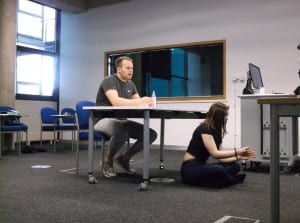Throughout the performance there are five short interludes where I get off the bike and care for an orchid. Once this happens the audience are effectively taken to the ‘real world’. As a company, we wanted to have one character who the audience could form a relationship with, whilst the others are simply an ensemble with ‘no identity’. This required me to understand my character inside and out. Konstantin Stanislavski believed “every action on stage must have an inner justification, be logical, coherent and real” (Stanislavski, 1963, p.8). It was the aim of the director from the outset to create a character who was precise in every movement. This influence was mainly drawn from Clov in Samuel Beckett’s Endgame (1957). Throguhout Endgame, Clov is meticulous and precise with all of his actions whilst caring for Hamm, which lets them ‘maintain an interdependent relationship’ (Silva da Bastos & Frias Matos, 2016, p.121) Together, the director and I wanted to achieve this relationship between my character and the orchid. Therefore, we decided to create interludes around the watering of the plant. Each interlude was consistent in content and accurate in movement e.g. how much water was applied and how the cloth was sprayed. This eventually formed a strong relationship between the man and his plant, as the interludes became almost a ritual.

The above photo shows myself and the choreographer in discussion regarding the precise movements needed in the interlude scene. Even-though we aimed for consistency throughout the short scenes, it was important we developed on the narrative. Therefore, we decided to create a slight change to each with the appearance of a faceless woman and the intergration of the creatures (ensemble). By integrating the woman and ensemble, the audience soon began to realise the two worlds collapsing onto one another and the mental deterioration of the man.
Works Cited:
Bastos da Silva, J & Frias Matos. (2016) A Time to Reason and Compare: International Modernism Revisited One Hundred Years After, London: Cambridge Scholars
Stanislavski, K. (1963) An Actors Handbook. New York: Routledge.
